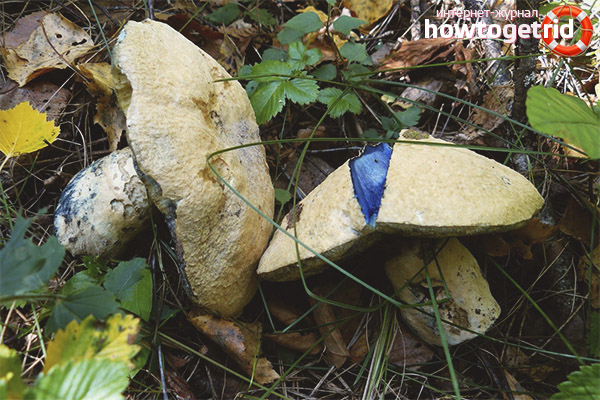The content of the article
One of the edible, and at the same time quite rare, and therefore not recommended for eating, types of mushrooms is the blue gyropoorus, also popularly known as the “bruise”, so-called for its very specific color reaction on the cut, which turns blue some time after collection. Despite the fact that this representative of the kingdom of mushrooms can be eaten without a doubt, it is not advisable to do this, because at present it is one of the endangered species listed in several regional Red Books of our country.
For many beginners or not too experienced mushroom pickers, a bruise accidentally discovered in the forest can be an unexpected find, which may well be located in the middle of the common mushrooms or boletus birch trees familiar to each of us. Most likely, many of those who are not familiar with this forest inhabitant will simply pass by, considering it not particularly edible. Or they’ll throw it away, mistaking it for a poisonous cutoff due to the specific blueing of the face, which can sometimes surprise even experienced fans of quiet hunting. Nevertheless, the gyroorus blue is one of the traditional representatives of the nature of our strip, and therefore deserves a closer look.
Description
The bruise fungus (in scientific Latin called Gyroporus cyanescens), also known as the bluish gyropoor or birch gyropoorus, belongs to the tubular fungi of the genus Gyroporus (gyropora) family of the Flight class Agaricomycetes. He received his names, both national and official, for the rare property of its pulp. For example, in a leg or hat, it is quickly able to change its original white color to bright and saturated blue. Moreover, in any place of damage, whether it is a cut of a mushroom knife, pressed finger marks or, for example, an animal bite.
The shape of the bruise hat varies depending on its age - in young mushrooms it has a convex shape, but gradually becomes flattened as it grows older. The mushroom peel has a pleasant matte appearance with a yellowish-brown or whitish-cream color, with the slightest damage it is covered with bright blue spots. To the touch, the surface of the blue gyropoor hat is dry, has a velvety felt texture. Its average diameter is 5-8 centimeters, although there are often specimens with a hat width of 15 centimeters.
The pulp of the bruise mushroom has a white or delicate cream color, easily breaks, acquiring a cornflower hue at the place of break or slice. The taste is nutty, there is practically no characteristic odor. The tubular layer of the fungus, up to 10 millimeters thick, with small pores, also has a white or cream shade that immediately turns blue when it is damaged. The spore powder has a pale yellowish color.
The smooth leg of the bluish gyropoor, devoid of a ring, reaches a thickness of up to 3 centimeters, and a height of 5 to 10 centimeters. At the base, it is thickened, and under the hat has a pointed shape. The color, as a rule, is either white, or copying the color of the hat, sharply giving off to the blue after touching. The structure of the legs of a young mushroom is dense, while in an adult it is hollow. A bruise is considered an edible fungus that belongs to the second food category, with a taste that is not bitter in food, and has quite good nutritional value, for example, in comparison with other representatives of its family, such as chestnut gyroporus.
Distribution and collection

Gyroporus is blue, it is a bruise, every year it is found less and less.In some regions, it is officially listed in the Red Book. On the territory of the country, the mushroom grows in deciduous and mixed forests, in the temperate zone, in an area with a humid climate, on the roots of birch, chestnuts and oaks. One common habitat is sandy soil. Mushroom picking can begin from mid-summer, and it lasts until mid-autumn - until October.
Similar views
Eating
Mushroom bruise has a pleasant nutty taste and subtle mushroom aroma, can be eaten both boiled and fried, as well as in the form of preparations for the winter - dried or pickled. Excellent caviar and various sauces made of blue gyropoors are distinguished by their excellent taste. However, not everyone can be happy with the dishes prepared from it - in some regions of the country a bruise is listed in the Red Book. The fact is that it bears fruit very poorly and spreads, and therefore is extremely rare. Therefore, cutting such mushrooms is not recommended.
Video: bruise (Gyroporus cyanescens)










Submit